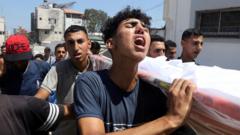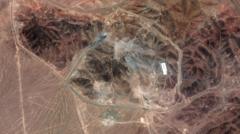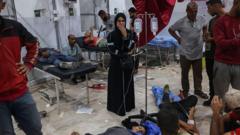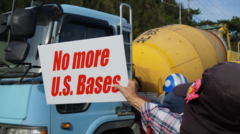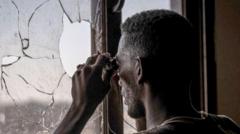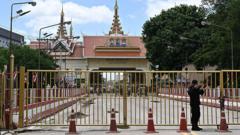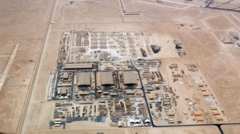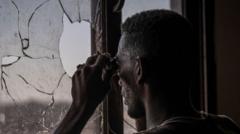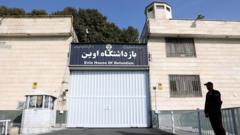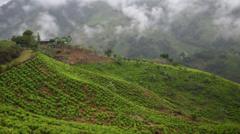**Description**
**Title**
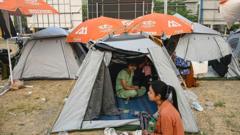
**Title**
Myanmar's Earthquake Relief Efforts Hampered by Military Control
Military authorities hinder aid access following a devastating earthquake in Myanmar, raising concerns of humanitarian exploitation.
**Summary**
Amid the aftermath of a 7.7 magnitude earthquake, military blockades and attacks on aid convoys in Myanmar pose significant obstacles to relief efforts. Despite junta leader Min Aung Hlaing's call for international assistance, on-ground realities reflect a pattern of weaponizing aid to control resources and punish resistance-held areas.
In the wake of a catastrophic 7.7 magnitude earthquake on March 28 that has claimed more than 2,886 lives, Myanmar's military junta has faced serious criticism for obstructing humanitarian efforts. Reports indicate that rescue teams encountered considerable hurdles imposed by military authorities, which severely limited access to the most affected regions. Human rights and aid organizations voiced their concerns, stating that the military enforced curfews, set up long checkpoints, and conducted thorough inspections of relief supplies, preventing timely assistance from reaching those in peril in a critical 72-hour window estimated to be paramount for rescue operations.
Junta chief Min Aung Hlaing’s appeal for international help stands in stark contrast to the realities on the ground. After the earthquake, he claimed he had opened all channels for foreign aid. However, eyewitness accounts from rescue workers tell a different story, reflecting a pattern where the military restricts aid delivery based on its control over the territory—only allowing aid into areas under its jurisdiction while blocking assistance to regions aligned with resistance groups. John Quinley of Fortify Rights articulated the situation, indicating that the military intentionally chooses when and how aid flows into different regions, often using it as a strategic weapon.
The current military regime, having established itself through force since its takeover in 2021, has a history of manipulating humanitarian assistance amid natural calamities, as seen during previous disasters like Cyclone Mocha. In the last few days alone, an aid convoy supported by the Chinese Red Cross came under gunfire from military forces, highlighting the dangerous environment aid workers face.
Aid agencies report acute shortages of essential supplies such as food, water, and fuel, alongside the dire situation of numerous residents now without shelter. The military has also imposed burdensome bureaucratic processes on aid organizations, aiming to confine their operations strictly within its oversight.
Despite these challenges, some aid workers remain optimistic about overcoming the junta's restrictions, especially given the severe scale of the recent disaster. Nevertheless, the precarious nature of the situation is compounded by ongoing military actions, including airstrikes that have occurred in the same timeframe, further complicating the humanitarian landscape.
The junta's fluctuating stance on ceasefire arrangements further underscores the unpredictable nature of delivering aid. Although initially resistant, the regime has now accepted a temporary ceasefire to facilitate relief efforts, yet many fear this may not effectively change the underlying issues of aid suppression.
In this complex scenario, NGOs and humanitarian actors emphasize the critical need for monitoring aid flows to ensure assistance reaches those most in need rather than being diverted for military purposes. Despite the junta's claims and public appeal for help, skepticism persists regarding their commitment to genuine humanitarian access, prompting activists to remain vigilant in assessing the true impact of aid efforts in Myanmar.
**Summary**
Amid the aftermath of a 7.7 magnitude earthquake, military blockades and attacks on aid convoys in Myanmar pose significant obstacles to relief efforts. Despite junta leader Min Aung Hlaing's call for international assistance, on-ground realities reflect a pattern of weaponizing aid to control resources and punish resistance-held areas.
In the wake of a catastrophic 7.7 magnitude earthquake on March 28 that has claimed more than 2,886 lives, Myanmar's military junta has faced serious criticism for obstructing humanitarian efforts. Reports indicate that rescue teams encountered considerable hurdles imposed by military authorities, which severely limited access to the most affected regions. Human rights and aid organizations voiced their concerns, stating that the military enforced curfews, set up long checkpoints, and conducted thorough inspections of relief supplies, preventing timely assistance from reaching those in peril in a critical 72-hour window estimated to be paramount for rescue operations.
Junta chief Min Aung Hlaing’s appeal for international help stands in stark contrast to the realities on the ground. After the earthquake, he claimed he had opened all channels for foreign aid. However, eyewitness accounts from rescue workers tell a different story, reflecting a pattern where the military restricts aid delivery based on its control over the territory—only allowing aid into areas under its jurisdiction while blocking assistance to regions aligned with resistance groups. John Quinley of Fortify Rights articulated the situation, indicating that the military intentionally chooses when and how aid flows into different regions, often using it as a strategic weapon.
The current military regime, having established itself through force since its takeover in 2021, has a history of manipulating humanitarian assistance amid natural calamities, as seen during previous disasters like Cyclone Mocha. In the last few days alone, an aid convoy supported by the Chinese Red Cross came under gunfire from military forces, highlighting the dangerous environment aid workers face.
Aid agencies report acute shortages of essential supplies such as food, water, and fuel, alongside the dire situation of numerous residents now without shelter. The military has also imposed burdensome bureaucratic processes on aid organizations, aiming to confine their operations strictly within its oversight.
Despite these challenges, some aid workers remain optimistic about overcoming the junta's restrictions, especially given the severe scale of the recent disaster. Nevertheless, the precarious nature of the situation is compounded by ongoing military actions, including airstrikes that have occurred in the same timeframe, further complicating the humanitarian landscape.
The junta's fluctuating stance on ceasefire arrangements further underscores the unpredictable nature of delivering aid. Although initially resistant, the regime has now accepted a temporary ceasefire to facilitate relief efforts, yet many fear this may not effectively change the underlying issues of aid suppression.
In this complex scenario, NGOs and humanitarian actors emphasize the critical need for monitoring aid flows to ensure assistance reaches those most in need rather than being diverted for military purposes. Despite the junta's claims and public appeal for help, skepticism persists regarding their commitment to genuine humanitarian access, prompting activists to remain vigilant in assessing the true impact of aid efforts in Myanmar.

